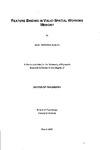FEATURE BINDING IN VISUO-SPATIAL WORKING MEMORY
| dc.contributor.author | ELSLEY, JANE VICTORIA | |
| dc.contributor.other | Faculty of Science and Engineering | en_US |
| dc.date.accessioned | 2013-09-19T12:42:54Z | |
| dc.date.available | 2013-09-19T12:42:54Z | |
| dc.date.issued | 2007 | |
| dc.identifier | NOT AVAILABLE | en_US |
| dc.identifier.uri | http://hdl.handle.net/10026.1/1886 | |
| dc.description.abstract |
Four series of experiments using a paradigm adapted from Prabhakaran at al. (2000) are presented exploring the characteristics of bound visuo-spatial representations in memory. This thesis was guided by the following theoretical questions: (1) Can location binding be demonstrated in a recognition paradigm? (2) What are the temporal dynamics of location binding? (3) Is location binding automatic, or rather, does it require attentional resources? (4) What are the products of location binding: Whole new objects or links between features that contribute in an asymmetrical manner? Series 1 addressed the first question through the demonstration of binding effects across two experiments. Series 1 was additionally informative with respect to the second question in demonstrating that binding emerged relatively early (within 250ms post stimulus offset) and could be maintained for at least four seconds. With regard to the automaticity with which visual and spatial features are integrated, and the characteristics of the resulting bound representations, three lines of evidence are reported. Firstly, by manipulating feature relevance, Series 2 demonstrated that binding may occur automatically when shapes are attended, but not when locations are attended. This finding is not easily compatible with the idea that location binding results in the creation of an entirely new construct in memory which would predict binding effects when either shapes or locations are attended. Secondly, it was demonstrated that increasing the amount of attention necessary for encoding the shape features enhanced the binding which took place when shapes only were attended (Experiment 3B) but had minimal effect on performance when locations only were attended (Experiment 3C). This suggests that while binding to location may occur automatically when shapes are the attended feature, the amount of attention allocated to those shapes may increase the size of the binding effect which ensues. Thirdly, it was demonstrated that the binding effect following attendance to both features was significantly reduced, but not eradicated under attentional load conditions (Experiment 4) suggesting that while binding to location may in part emerge automatically, bound representations may benefit from available attentional resources. The results are discussed in terms of a hierarchical structure to encoding in memory (e.g., Jiang et al., 2000) which suggests that the encoding of the spatial layout of the scene must occur prior to the encoding of what occupies those locations (see also Navon, 1977). We speculate that location binding in memory may be characterised by links formed between features in memory, while the feature information is itself stored in parallel (e.g., Wheeler & Treisman, 2002). In addition, the links may be unequally weighted, an aspect of binding which may arise as a result of the order of encoding visual and spatial features. | en_US |
| dc.language.iso | en | en_US |
| dc.publisher | University of Plymouth | en_US |
| dc.title | FEATURE BINDING IN VISUO-SPATIAL WORKING MEMORY | en_US |
| dc.type | Thesis | |
| plymouth.version | Full version | en_US |
| dc.identifier.doi | http://dx.doi.org/10.24382/4021 |
Files in this item
This item appears in the following Collection(s)
-
01 Research Theses Main Collection
Research Theses Main


